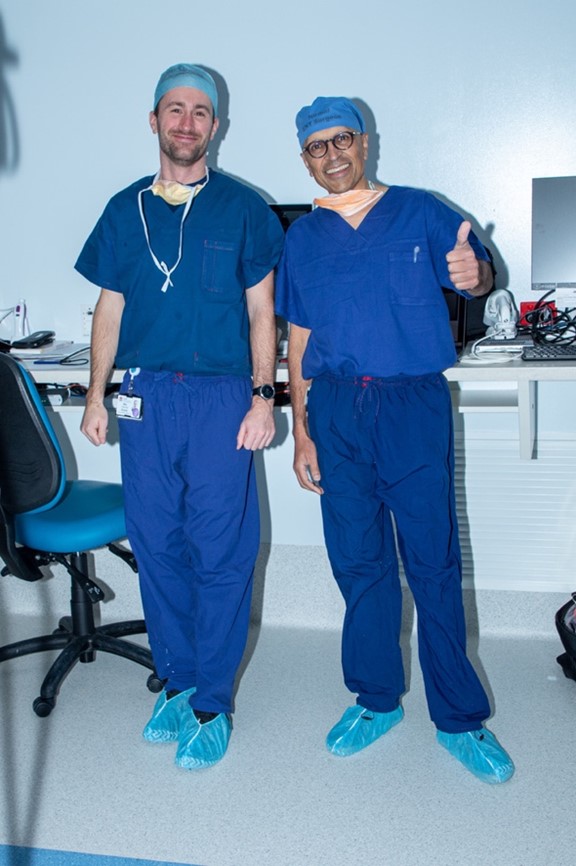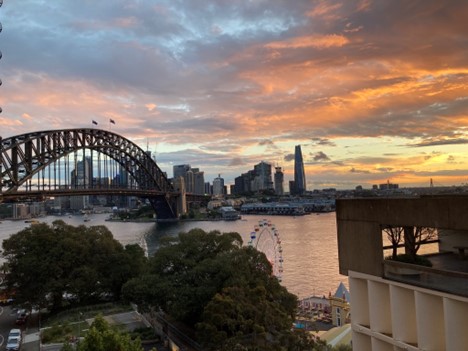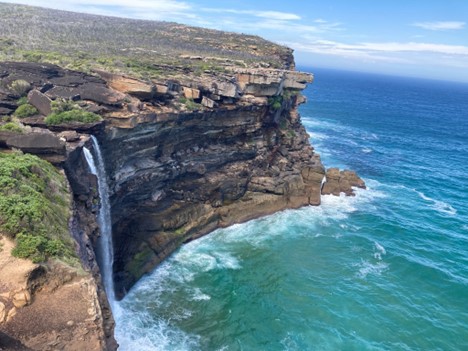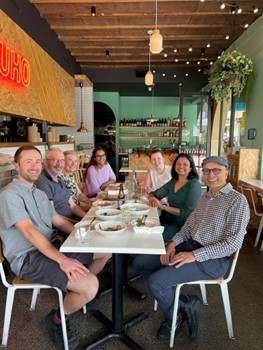The SEES fellowship was a lifechanging year for me, both professionally and personally. Completing an international fellowship at the height of the COVID-19 pandemic was wrought with unique challenges. In spite of these, I had an absolutely fantastic year and would enthusiastically recommend this fellowship to anyone who seeks to learn endoscopic ear surgery from the some of the very best in the world.
Fellowship began in July 2021 and was completed in June 2022. Very few people were allowed to enter the country when I left the U.S. because the Australian government was taking heavy precautions to minimize spread of the virus. After a two-week mandatory quarantine, my training experience began. Over the succeeding weeks I began to build a foundation of knowledge and skills essential to becoming a competent endoscopic ear surgeon. Just as things were gaining momentum with regards to my professional development, the government put an indefinite halt to all elective surgery in an effort to conserve resources that may need to be allocated towards pandemic relief. This lasted 5-6 weeks, during which time my meager savings was rapidly being depleted resultant from the high cost of living. This was a challenging time. It’s important to know that this fellowship is not one that is paid off a salary. The fellow obtains privileges to work as a surgical assistant in the private hospitals, and generates income based off fees collected from assisting in surgeries. The income is sufficient to live off of, and is reliable, but there is a lag of 6-12 weeks from when one arrives in Australia (assuming the fellow is international), and when one begins to get paid. I mention this because for future fellows, I recommend positioning oneself to be able to live without any income for 12 weeks after arrival to Australia. Prof. Patel, being the resourceful man that he is, tapped into his connections and helped deploy me to work as medical doctor on the neurology unit in the public hospital, which helped occupy my time and mind while I eagerly awaited a return to elective surgery.
Eventually the restrictions on elective surgery were lifted and the training experience resumed, with gusto! A typical fortnight consisted of one-half day of operating at the public hospital with registrars (equivalent to what the U.S. calls “residents”), followed by a half day of clinic, and then 4 days of operating at the private hospitals with the consultants. The following week would have a full day of operating at the public hospital, followed by another 3.5-4 days of operating with the consultants at the various private hospitals. I was grateful to learn from four different, highly skilled surgeons. While they all collaborate and talk often, each surgeon had unique ways of operating and thinking. Each would have novel techniques they would employ in addressing surgical otologic scenarios. Operating in the public hospital offers a higher degree of autonomy. The balance between public and private was, in my opinion, a major strength to the fellowship. In the private it was like learning to fly in a flight simulator. The public hospital provided a place where I could leave the simulator and spread my own wings by trying out all the various techniques I was learning in the private with the various consultants, and find out what worked best in my own hands. I have never totalled the number of cases done during fellowship, but estimate it to be ~ 350. These largely consisted of surgeries for cholesteatoma, ossicular chain reconstructions, tympanoplasty, cochlear implantation (mostly Cochlear, some Med-El), osseointegrated implants (BAHA and Bone Bridge, and a few Sound Bridge), otosclerosis, exostectomies (similar to previous fellows, I didn’t know exostoses were real!) and repair of CSF leaks. There was adequate exposure to less common types of otologic surgery such as congenital cholesteatoma, glomus tumors and transmastoid approaches for superior semicircular canal dehiscence. There was also a healthy exposure to lateral skull base surgery, but not enough for me to feel confident to incorporate any surgery requiring a combined approach into my practice. Having been in private practice that’s heavily otology based in Northern California for several months, I feel that the SEES fellowship was exceptional in its purpose to prepare me to be a safe, effective, and competent otologist.
Throughout the year I had ample opportunity to explore Sydney and the surrounding areas. It’s a beautiful city with a remarkable culture. It’s incredibly diverse in its people, its cuisine, the types of entertainment; Sydney has not just something for everybody but rather many things for anybody! Nirmal, along with the other consultants, strongly encouraged me to travel and experience Australia while I was there. Having a training supervisor encouraging a trainee to take time off was a foreign concept to me, having completed all of my training in the U.S. It was an idea I initially resisted, but am grateful to say that I later embraced. In the latter half of fellowship, once travel restrictions were relaxed, I enjoyed traveling to various National Parks in New South Wales, as well as Queensland. One highlight was scuba diving at the Great Barrier Reef. As pleasant of a trip that was, my most memorable travel experience was visiting Tasmania and exploring that lovely land by camper van.
At the conclusion of the fellowship, I travelled to Europe where I attended the International Otology Course at the Causse Clinic led by Dr. Robert Vincent. Following this, I spent a few weeks completing an observership under Professor Daniele Marchioni in Modena, Italy. Both of these experiences were wonderful, and I thoroughly enjoyed making new friends with otologists from all over the world. Before returning to the U.S., I was able to visit the world headquarters of Med-El in Austria and take a private tour of the facilities. Sydney is the world headquarters for Cochlear, and I was fortunate to spend time touring their facilities as well. I felt quite lucky that I was able to get an up-close look at both of these impressive and innovative companies.
There is ample opportunity to be involved with research during the fellowship. One bonus of working this group is that they are extremely well connected with both their local and the global otology communities and it presents an easy, natural platform for networking. There is also plenty of opportunity to teach, which comes while working in the public hospitals. I enjoyed my interactions with the trainees in Sydney and learned from them perhaps as much or even more than they taught me.
One of the nicer things of this fellowship is that there is no obligation to take call. This opens up all the weekends and evenings (the ones where you’re not operating late, that is) to enjoying all that Sydney has to offer. Perhaps my one regret during my time in Sydney was not having a car. I relied on the public transportation system as well as bicycle to get around. This is more than adequate, and arguably easier, for the day-to-day work life and doing things in the city. However, it’s very challenging to explore on the weekends without a car.
The SEES fellowship was really the perfect fellowship for me. I’m incredibly grateful that I had the opportunity to spend a year living in Australia and training under such high-quality individuals. The fellowship helped to mold me into a better surgeon, and a better human being.

Student and Sensei

Kangaroo in Tassie

View from the balcony of my first apartment, in Milsons Point

Eagle Rock at Royal National Park

Holiday meal with the otology team at NSP




